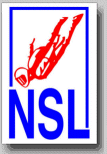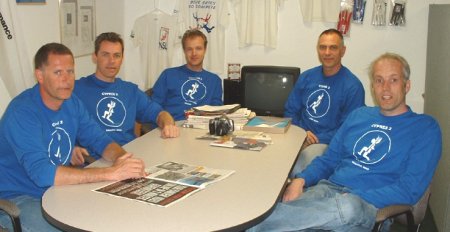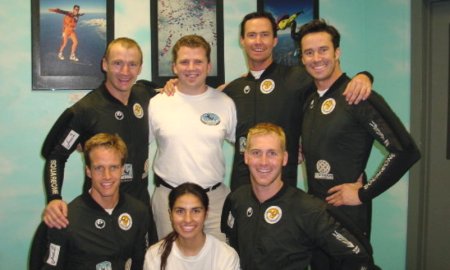
National
Skydiving
League
226 Pecan Street
Deland FL 32724
tel: (386) 801-0804
© 2003 - 2025
All Rights Reserved


226 Pecan Street
Deland FL 32724
tel: (386) 801-0804
© 2003 - 2025
All Rights Reserved


The article pointed out that body sizes have a direct relationship to the indoor meet conditions, which are not the same for everybody in smaller flying chambers.
The article related to the German national team in 4-way Open, Airbus, who probably combine for an average body height of at least 6 feet or 182 centimeters. However, the NSL News actually received feedback from one of the tallest 4-way competitors in the sport, who is in a position to share his valuable experiences naturally with 4-way teams and competitors who are not in the same situation.
 As a passionate and long-standing Formation Skydiving competitor, Lee Staebler shares his 6 feet and 5 inches of body height (less than 5 centimeters short of 2 meters) on a regular basis with his 4-way and 8-way team mates in flying chambers. He recently competed with two teams (Fire Ball XP4, SCZ Zeus) at the Paraclete XP Indoor Championship 2019, where the 16-foot flying chamber offers him more space than at all other wind tunnels in the United States.
As a passionate and long-standing Formation Skydiving competitor, Lee Staebler shares his 6 feet and 5 inches of body height (less than 5 centimeters short of 2 meters) on a regular basis with his 4-way and 8-way team mates in flying chambers. He recently competed with two teams (Fire Ball XP4, SCZ Zeus) at the Paraclete XP Indoor Championship 2019, where the 16-foot flying chamber offers him more space than at all other wind tunnels in the United States.
Paraclete XP Indoor 2019 | 1 | 2 | 3 | 4 | 5 | 6 | 7 | 8 | 9 | 10 | Total | Avg | |
|---|---|---|---|---|---|---|---|---|---|---|---|---|---|
| Rank | AAA Class | P,N,Q,1 | G,2,17 | 14,18,D | K,12,10 | 5,H,J,L | 19,M,7 | 15,13,8 | C,6,B,9 | 20,16,11 | E,3,O,A | Total | Avg |
| 1 | Arizona Airspeed | 38 | 30 | 25 | 25 | 42 | 31 | 23 | 44 | 23 | 36 | 317 | 31.7 |
| 2 | SDC Rhythm XP | 39 | 31 | 24 | 23 | 44 | 30 | 22 | 35 | 22 | 36 | 306 | 30.6 |
| 3 | Golden Knights Gold | 30 | 27 | 22 | 19 | 34 | 26 | 20 | 35 | 21 | 29 | 263 | 26.3 |
| 4 | Ranch 2nd Generation | 31 | 26 | 23 | 22 | 30 | 27 | 18 | 30 | 21 | 28 | 256 | 25.6 |
| 5 | XPG4 | 30 | 22 | 20 | 19 | 31 | 24 | 19 | 28 | 17 | 27 | 237 | 23.7 |
| 6 | Lite XP | 25 | 19 | 16 | 17 | 23 | 24 | 17 | 26 | 17 | 27 | 211 | 21.1 |
| 7 | Great Expectations | 27 | 15 | 18 | 17 | 24 | 23 | 16 | 24 | 13 | 24 | 201 | 20.1 |
| 8 | Air Force Shadow | 25 | 20 | 15 | 15 | 27 | 20 | 16 | 25 | 15 | 22 | 200 | 20.0 |
| 9 | Perris Force | 27 | 16 | 16 | 16 | 20 | 22 | 14 | 23 | 14 | 23 | 191 | 19.1 |
| 10 | Vega XP | 22 | 13 | 15 | 12 | 21 | 23 | 15 | 24 | 15 | 20 | 180 | 18.0 |
| 10 | Phoenix XP | 22 | 17 | 15 | 16 | 20 | 20 | 14 | 20 | 15 | 21 | 180 | 18.0 |
| 12 | SDC Rhevolution XP | 23 | 14 | 14 | 14 | 19 | 20 | 14 | 21 | 15 | 17 | 171 | 17.1 |
| 13 | Fire Ball XP4 | 23 | 14 | 15 | 14 | 21 | 18 | 15 | 16 | 12 | 21 | 169 | 16.9 |
| 14 | Air Force Boomers | 22 | 16 | 12 | 14 | 22 | 18 | 15 | 18 | 10 | 15 | 162 | 16.2 |
| 15 | Lucky Joshua | 21 | 13 | 14 | 13 | 17 | 17 | 14 | 17 | 13 | 20 | 159 | 15.9 |
| 16 | SCZ ZEUS 3.5 | 19 | 15 | 13 | 12 | 18 | 15 | 10 | 18 | 11 | 17 | 148 | 14.8 |
| 17 | A Bunch of Misfits Winto a Bar | 17 | 13 | 13 | 14 | 20 | 18 | 13 | 11 | 11 | 16 | 146 | 14.6 |
| 18 | Airtrocity | 18 | 14 | 12 | 12 | 18 | 17 | 13 | 17 | 10 | 14 | 145 | 14.5 |
| 19 | NSL4XIC | 18 | 12 | 10 | 9 | 16 | 15 | 10 | 15 | 10 | 13 | 128 | 12.8 |

He learned to fly in the 12-foot chamber of SkyVenture Orlando, which was built in 1998. There he was so fortunate to train with one of the most experienced 4-way competitors and coaches in the history of the sport.
Pete Allum lived in Florida at that time and provided Lee Staebler with all the knowledge and skills training that would allow him to acquire the precision and accuracy that he would need to share a 12-foot chamber with three other 4-way fliers. Lee Staebler remembers the very early days of indoor 4-way training:
"I was not skilled enough to do 4-way at the time but was mesmerized watching a Dutch 4-way team alternate rotations with us. I was actually talking with Paul Hofstee at the most recent Paraclete tunnel competition about that experience who was on that team those many years ago. Pete was pointing out Paul's optimal body position to me."
The flying chamber did not get any larger for him when he moved north and continued at SkyVenture New Hampshire.
Fire Ball XP4 and SCZ Zeus at the Paraclete XP Indoor Championship 2019

Then the 14-foot wind tunnels proliferated and are now the standard size in the United States. Europe has a much higher number of wind tunnels with 16-foot flying chambers, while Paraclete XP is still the only one in North America.
The U.S. travel distances became much shorter to visit a 14-foot wind tunnel, and there was and is now a critical balance between travel efforts and expenses and the comfort of Paraclete's 16-foot flying chamber. Lee Staebler said that he finally made his first real 4-way training with Eliana Rodriguez and Craig Girard at SkyVenture Arizona's 14-foot tunnel. He continued to improve his skills, and the smaller flying chamber did not hurt so much any longer:
"Of course I tend to fly with smaller people, some on the short side, so that my being 'too tall' and their being short cancel each other out in effect."

However, Lee Staebler thinks that smaller flying chambers have their benefits for training purposes: "I had to work much harder to emphasize a more precise, controlled flying style being as tall as I am. That was and is what I have always sought anyway, as the precision and grace of a Pete Allum and Craig Girard was my goal. I so admired their abilities, and I wanted to emulate them as much as I could. In training I believe it is to the tall flier’s advantage because it forces one to be more attentive to flying better than needed in an area that is more forgiving."
 It's a different story when it comes to competition though: "I believe it is a disadvantage to the taller flyer. Especially a team of taller fliers competing against a team of smaller fliers. All things being equal, the smaller fliers have the advantage of using up less space. 16-foot chambers for competition would level the playing field in my opinion.”
It's a different story when it comes to competition though: "I believe it is a disadvantage to the taller flyer. Especially a team of taller fliers competing against a team of smaller fliers. All things being equal, the smaller fliers have the advantage of using up less space. 16-foot chambers for competition would level the playing field in my opinion.”
Lee Staebler is impressed when he watches a tall team fly really well in a 14-foot chamber: "They have to be that much more precise." He knows what he is talking about...